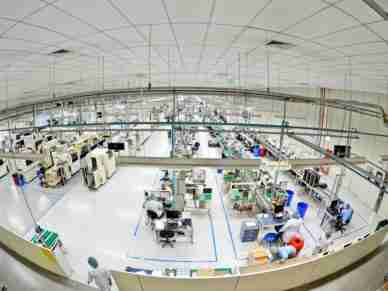
Boosting efficiency in a facility involves more than reducing waste and increasing output. It is about implementing innovative strategies that optimize operations, streamline communication and fully utilize available resources.
With the rapid advancement of technology and growing demands on productivity, facility managers must find creative ways to maximize efficiency while maintaining a safe and engaging work environment. Here are seven effective strategies for enhancing facility efficiency, focusing on innovation and adaptability.
1. Optimize Facility Layout and Flow
A well-designed facility layout can have a profound impact on operational efficiency. Poor facility flow often leads to bottlenecks, excess handling and increased production times, all of which decrease productivity. Conducting a detailed analysis of a facility’s layout and adjusting key areas can eliminate wasted motion and time, leading to smoother operations.
Incorporating tools like simulation software allows facility managers to visualize how materials, people and products move throughout the workspace. This digital twin approach enables experimentation with different layouts without disrupting day-to-day operations. The goal is to reduce unnecessary movement and ensure resources are positioned to flow naturally through the operating floor.
2. Implement Automation and Robotics
Automation has long been a go-to for improving operational efficiency, and its potential continues to grow. In recent years, robotics and artificial intelligence advancements have transformed how facilities operate. In fact, global sales of industrial robots reached a new peak in 2021 and 2022, with over 500,000 installed, indicating a growing reliance on automated solutions to drive efficiency.
Incorporating robotics in areas such as material handling, packaging and quality control can help facilities significantly reduce the time spent on repetitive tasks, freeing up humans for more complex and value-driven work. Additionally, automation reduces human error, enhancing overall precision and output quality. Modern robotics systems can integrate seamlessly with other manufacturing technologies, enabling more data-driven decisions, which lead to optimized workflows and increased productivity.
3. Leverage Data-Driven Decision Making
Data is one of the most powerful tools for boosting efficiency. With the rise of the Industrial Internet of Things (IIoT), facilities can now track various performance metrics in real time. From machine utilization rates to energy consumption, data can provide critical insights into operational inefficiencies that may not be apparent through manual observation.
For instance, dashcams offer real-time video surveillance that can be invaluable for monitoring vehicles, ensuring safety and compliance, and reviewing any incidents on-site. They serve as an additional data source that enhances both security and operational oversight.
Facilities that implement IIoT devices can also make use of predictive maintenance strategies. Rather than relying on scheduled maintenance, predictive maintenance utilizes sensors and data analytics to anticipate when equipment is likely to fail, allowing for timely interventions. It can reduce breakdowns by 70% and lower maintenance costs by 25%. In addition, it also extends the life of machinery, reducing overall capital expenditure.
4. Adopt Lean Manufacturing Principles
Lean manufacturing remains one of the most effective methodologies for boosting efficiency in a facility. In the automotive industry, lean principles aim to eliminate waste in all forms — excess materials, time or energy. When manufacturers invest time in value-adding activities and eliminating processes that do not directly contribute to the final product, they can significantly reduce operational costs while improving overall output.
Companies that successfully implement lean practices can reduce lead times and increase productivity. Lean manufacturing also encourages continuous improvement, empowering employees at all levels to identify inefficiencies and propose solutions. This inclusive approach fosters a culture of accountability and innovation, where small, incremental changes lead to substantial gains over time.
5. Introduce Flexible Offices
In-plant offices are becoming a key asset in improving facility efficiency. These modular structures provide office spaces within the facility floor, allowing managers and other key personnel to stay closer to operations.
They’re fully operable in approximately 25% of the time it takes to complete a conventional construction project, and they enable immediate communication, quicker decision-making and faster responses to issues on the floor. Incorporating them can also improve team collaboration by reducing the time it takes to communicate between departments.
When the leadership team is stationed close to production lines, they have better oversight and can interact more easily with workers, solving problems in real time. Additionally, modular in-plant offices can be easily reconfigured or expanded as the facility’s needs evolve, providing long-term flexibility.
6. Utilize Energy Efficiency Solutions
Electricity costs can comprise a considerable portion of operational expenses, and inefficient use can severely hamper productivity. Implementing efficiency solutions helps the environment, dramatically minimizes spending and improves overall efficiency.
Start by conducting an energy audit to identify areas where waste occurs, such as outdated lighting systems, heating, ventilation and air conditioning inefficiencies, or poorly insulated structures. Solutions like LED lighting, smart thermostats and energy management systems can provide real-time insights into power usage and help facilities adjust their operations to reduce consumption.
Moreover, some efficiency improvements may qualify for tax incentives or rebates, further lowering expenses. Reducing consumption also aligns with corporate sustainability goals — a factor increasingly prioritized by both consumers and investors.
7. Invest in Employee Training and Development
While technology plays a significant role in boosting efficiency, it is important to remember workers are still a facility’s most valuable resource. Investing in staff training and development ensures they are proficient in operating advanced machinery and engaged and motivated to contribute to operational improvements.
Continuous learning programs help teams adapt to new technologies, fostering a culture of innovation and problem-solving. Notably, 76% of employees say they would stay longer at a company that invested in their learning and development. A well-trained workforce is more likely to identify inefficiencies, suggest improvements and work collaboratively to enhance productivity.
Training can also include cross-training employees to perform multiple roles. This flexibility allows for better coverage during high demand or when certain people are unavailable. Cross-training can reduce downtime caused by staffing shortages and improve overall workplace resilience.
Unlocking Greater Facility Efficiency for Long-Term Success
Boosting facility efficiency requires a holistic approach that integrates technology, employee development and operational restructuring. Implementing creative strategies like automation, optimizing layouts, leveraging data and incorporating flexible workspaces can aid facility managers in improving overall productivity.
Also, ongoing worker development and a focus on lean principles ensure efficiency gains are sustainable in the long term. With these strategies in place, manufacturers can better meet the demands of modern production environments while maintaining a competitive edge in the marketplace.
















Leave a Reply